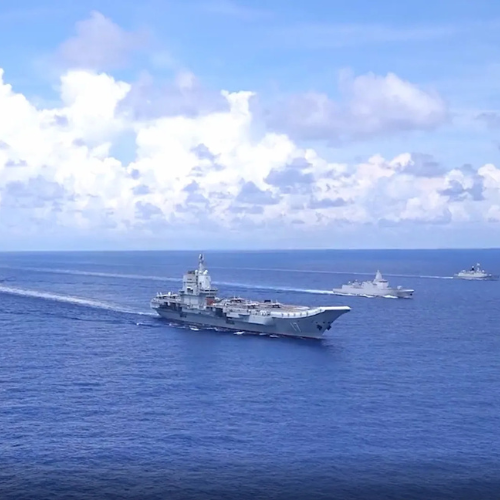A Chinese aircraft carrier recently made headlines as it sailed back into the South China Sea, raising questions about the country’s intentions in the region. The news came as the People’s Liberation Army Navy (PLAN) carried out a series of activities, involving both military exercises and a show of force in a region already known for its disputes over land and sea territories.
Chinese Aircraft Carrier Departure and Operations
On Monday night, CNS Shandong (17), one of China’s largest and most powerful aircraft carriers, moved out of the Philippine Sea and headed back into the South China Sea. According to Japan’s Joint Staff Office (JSO), the aircraft carrier was seen sailing along with its support ships, including the cruiser CNS Yan’an (106) and the destroyer CNS Zhanjiang (165). This move marked a shift in the Chinese navy’s deployment, which had seen the Shandong previously operating in the Philippine Sea earlier this year.
During this operation, the Shandong carrier conducted multiple launches and landings of its fighter jets. According to reports, it completed 10 launches and recoveries, which shows that the carrier’s aircraft were actively used in training or combat preparation. Additionally, helicopters on board the ship made a total of 10 take-offs and landings, further proving the ship’s readiness for operations in the region.
This series of movements was part of the Shandong Carrier Strike Group (CSG), which sailed into international waters east of the Philippines. Japan’s Maritime Self-Defense Force (JMSDF) kept track of the Chinese ships, with the JS Yugiri (DD-153) destroyer shadowing the group as it moved through the area. While this might seem like a routine military operation, the deployment of such a powerful fleet raises concerns due to the ongoing tension in the region.
Chinese Aircraft Carrier Causes Stir: Tensions Rise Near Japanese Islands
Philippines Military Exercise and Chinese Activities
At the same time, the Armed Forces of the Philippines (AFP) were conducting their own military exercises, called AJEX “DAGIT-PA”, which started on Monday. The exercise is designed to improve the capabilities of the Philippines’ army, air force, navy, and marines, and it will continue until November 15. The drills are taking place along the northwest coast of the Philippines, specifically on Luzon and Palawan Islands, areas near the South China Sea.
Interestingly, the location of the Chinese aircraft carrier deployment was not far from where the Philippine forces were conducting their drills, though it was in international waters. The presence of CNS Shandong near the Philippines comes at a time when many countries in the region, especially the Philippines, are concerned about China’s growing presence in the South China Sea. Although China has not made any official statements about the purpose of this deployment, it adds to the tension in an area where there are competing claims over islands, reefs, and waters.
U.S. Aircraft Carrier Heading to Japan
Meanwhile, the USS George Washington (CVN-73), a U.S. aircraft carrier, is preparing to arrive in Yokosuka, Japan in the coming weeks. This marks a changeover as the USS Ronald Reagan (CVN-76) departs Japan, making way for the George Washington to take its place. The U.S. Navy has been a strong presence in the region for decades, and the arrival of the George Washington is seen as part of a strategic effort to maintain stability in the area. The Carrier Air Wing 5, based on the George Washington, will also play a key role in helping ensure Japan’s security and peace in the region.
Japan has closely monitored these developments, and the government has made it clear that it values the role of the U.S. Navy in promoting regional peace. The presence of U.S. carriers like the George Washington and its air wing is seen as a way to maintain balance in a region where tensions are high, especially in the South China Sea, where China has been increasingly assertive.
As these two powerful navies—the Chinese and the American—move in close proximity to each other, there is no official word from China about the purpose of its deployment of the Shandong. However, this continued show of naval strength, both by China and the U.S., makes it clear that the South China Sea remains a significant point of interest and tension in global geopolitics.


